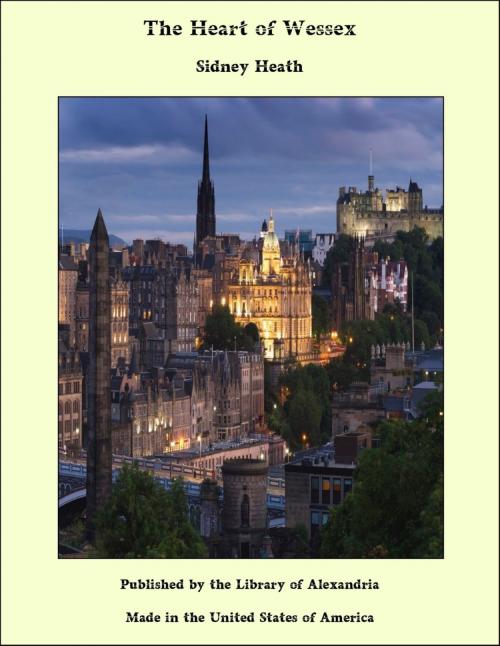| Author: | Sidney Heath | ISBN: | 9781465624161 |
| Publisher: | Library of Alexandria | Publication: | March 8, 2015 |
| Imprint: | Language: | English |
| Author: | Sidney Heath |
| ISBN: | 9781465624161 |
| Publisher: | Library of Alexandria |
| Publication: | March 8, 2015 |
| Imprint: | |
| Language: | English |
As the tourist must have a centre, a starting-off place for his various excursions, the visitor to the Hardy country cannot do better than make his headquarters at Dorchester, the Durnovaria of the Romans and the "Casterbridge" of the novels. Alighting at either of the railway stations, for the town is well served by both the Great Western and the South Western Companies, the visitor who has learned that Dorchester occupies the site of an important town of the Romans will probably receive a shock at the prevailing note of modernity that confronts him on every side. It is only when one begins to understand the planning of the streets, and has visited the town's outlying earthworks of Maumbury and Poundbury, that the mind can realize the possibility of a Roman town being buried a few feet beneath the houses that line the narrow thoroughfares. It has been said that one cannot plant a shrub in a Dorchester garden without unearthing some link with the legions of imperial Rome, an excusable exaggeration if we think of the vast number of treasures that have been discovered wherever the layer of surface soil has been penetrated; and there is every reason to believe that the foundations of Roman Dorchester lie just below the gardens, houses, and pavements of the bright and modern town. Excavation in the scientific sense the town has happily been spared, but the accidental finds are of great value, as proving that the town's historic past recedes into that twilight of dreamland and myth which veils the infancy of our island in a golden haze of mystery. All around this capital of Dorset lies a storied land, wherein memories of the Durotriges, of the Roman legions, and of the ruthless march of the Saxon through the beautiful land of Britain jostle with modern associations of poetry, literature, and art. Proceeding along South Street, as the narrow thoroughfare that connects the stations with the centre of the town is called, the first building to claim attention is the Grammar School, founded in the sixteenth century by a Thomas Hardy, and rebuilt in the same style in 1879. Adjoining the school is "Napper's Mite", a small seventeenth-century almshouse with a picturesque open gallery and a clock bracket, copied from the one that adorns the old George Inn at Glastonbury. The almshouse clock came from the old workhouse near by when it was pulled down. Farther along the street, but on the opposite side, is the Antelope Hotel, a Jacobean building whose beauties are concealed behind nineteenth-century walls, although some interior panelling and carving remain in situ.
As the tourist must have a centre, a starting-off place for his various excursions, the visitor to the Hardy country cannot do better than make his headquarters at Dorchester, the Durnovaria of the Romans and the "Casterbridge" of the novels. Alighting at either of the railway stations, for the town is well served by both the Great Western and the South Western Companies, the visitor who has learned that Dorchester occupies the site of an important town of the Romans will probably receive a shock at the prevailing note of modernity that confronts him on every side. It is only when one begins to understand the planning of the streets, and has visited the town's outlying earthworks of Maumbury and Poundbury, that the mind can realize the possibility of a Roman town being buried a few feet beneath the houses that line the narrow thoroughfares. It has been said that one cannot plant a shrub in a Dorchester garden without unearthing some link with the legions of imperial Rome, an excusable exaggeration if we think of the vast number of treasures that have been discovered wherever the layer of surface soil has been penetrated; and there is every reason to believe that the foundations of Roman Dorchester lie just below the gardens, houses, and pavements of the bright and modern town. Excavation in the scientific sense the town has happily been spared, but the accidental finds are of great value, as proving that the town's historic past recedes into that twilight of dreamland and myth which veils the infancy of our island in a golden haze of mystery. All around this capital of Dorset lies a storied land, wherein memories of the Durotriges, of the Roman legions, and of the ruthless march of the Saxon through the beautiful land of Britain jostle with modern associations of poetry, literature, and art. Proceeding along South Street, as the narrow thoroughfare that connects the stations with the centre of the town is called, the first building to claim attention is the Grammar School, founded in the sixteenth century by a Thomas Hardy, and rebuilt in the same style in 1879. Adjoining the school is "Napper's Mite", a small seventeenth-century almshouse with a picturesque open gallery and a clock bracket, copied from the one that adorns the old George Inn at Glastonbury. The almshouse clock came from the old workhouse near by when it was pulled down. Farther along the street, but on the opposite side, is the Antelope Hotel, a Jacobean building whose beauties are concealed behind nineteenth-century walls, although some interior panelling and carving remain in situ.















